Kecap Manis Recipe
This post may contain affiliate links. See my disclosure policy.
There’s a reason Kecap Manis is the most popular condiment in Indonesia: It’s not only delicious, it’s so incredibly versatile you’ll find yourself wanting to add it to nearly everything! This homemade kecap manis recipe is made from scratch and will keep in the fridge for several weeks.
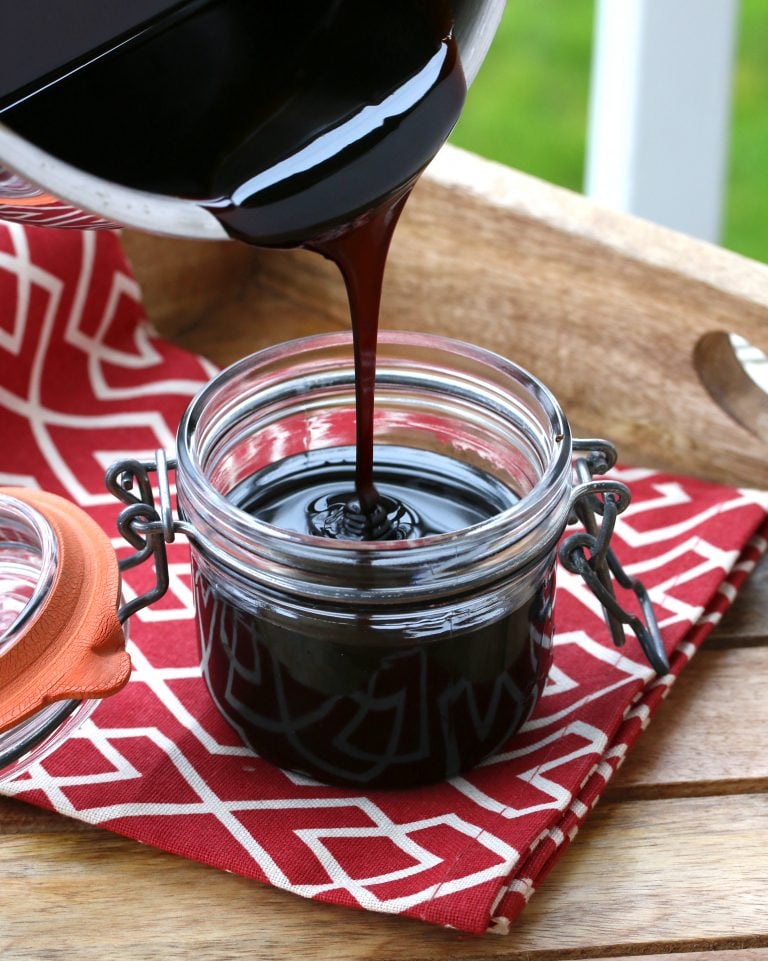
Indonesian Sweet Soy Sauce
A meal in Indonesia is virtually incomplete without ketcap manis, the most popular condiment in the country! It’s not only the most popular condiment, it’s the most widely used condiment in Indonesia. So much so that over 90% of soy sauce production in Indonesia goes towards making kecap manis. Kecap manis is such a deliciously versatile sauce and will do wonders for a vast variety of Asian-inspired dishes!
What is Kecap Manis?
Also known as ketjap manis, it’s a thick and dark molasses-like sauce with palm sugar and soy sauce as its base and with the addition of aromatic spices for flavor. The word manis means “sweet” in Malay/Indonesian and so the sauce is often referred to as “sweet soy sauce.”
The method for making it is much like a balsamic vinegar reduction wherein the ingredients are slowly simmered until the sauce naturally thickens into a syrupy consistency. Traditionally palm/coconut sugar is used which gives the sauce deep caramelly and butterscotch undertones. Kecap manis has been popular in Indonesia for…well, for a very, very long time. Interestingly it is also quite popular in the Netherlands because of the influence of Dutch colonialism in Indonesia in from the late 16th century until 1945.
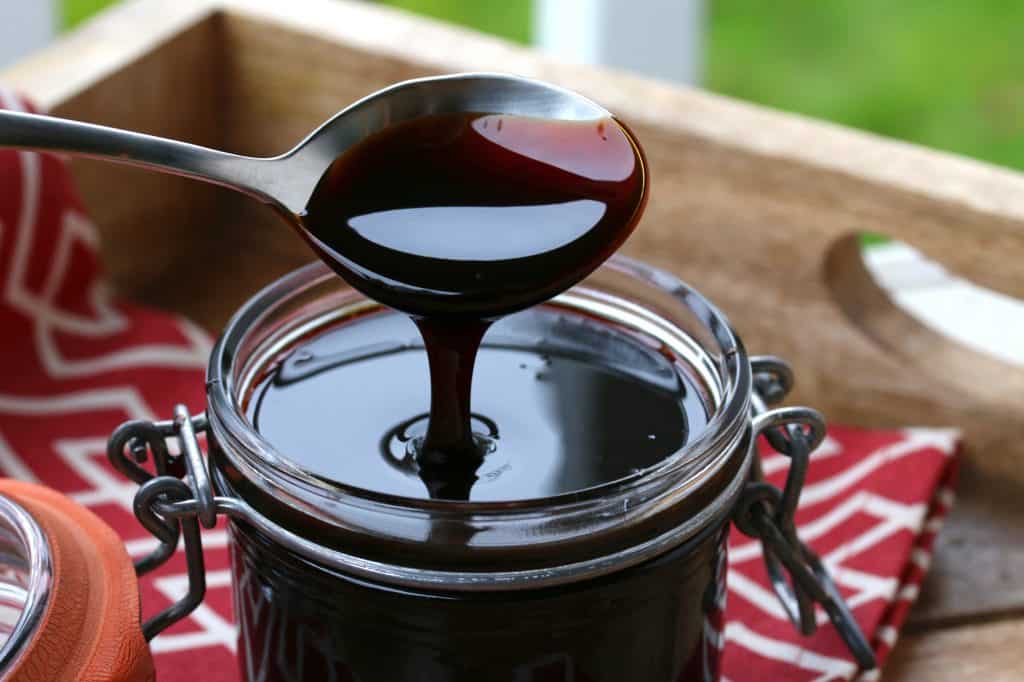
Where Did it Originate?
I recently read an article discussing the history of kecap manis in Indonesia. Though most Indonesians today buy their kecap manis in bottles at the grocery store that wasn’t always so. In earlier days it wasn’t available in bottles produced by huge manufacturers. Instead local families built their livelihood on it and produced and sold it at the local markets. The city of Majalengka alone used to have 300 different local vendors who produced their own versions of kecap manis, each with their own distinct flavor variations.
But then Heinz and Unilever took over two of the brands, ABC and Bango, and local producers couldn’t compete with their advertising power. As a result many of family-run businesses who had been making kecap manis for generations were forced out of business. Another result is that the vast variety of kecap manis sauces dwindled down to a small handful of bottled brands, the unique local variations largely lost.
Well, I’m sticking with homemade kecap manis. Not only is it free of the junk ingredients and preservatives found in the bottled versions, it also tastes MUCH better! Plus it’s super easy to make so there really just is no excuse not to make your own. With Indonesia’s past tradition of a vast variety of flavor variations, feel free to experiment with other flavors by adding ingredients like black peppercorns, chilies, coriander seeds, lemongrass and kaffir or curry lime leaves.
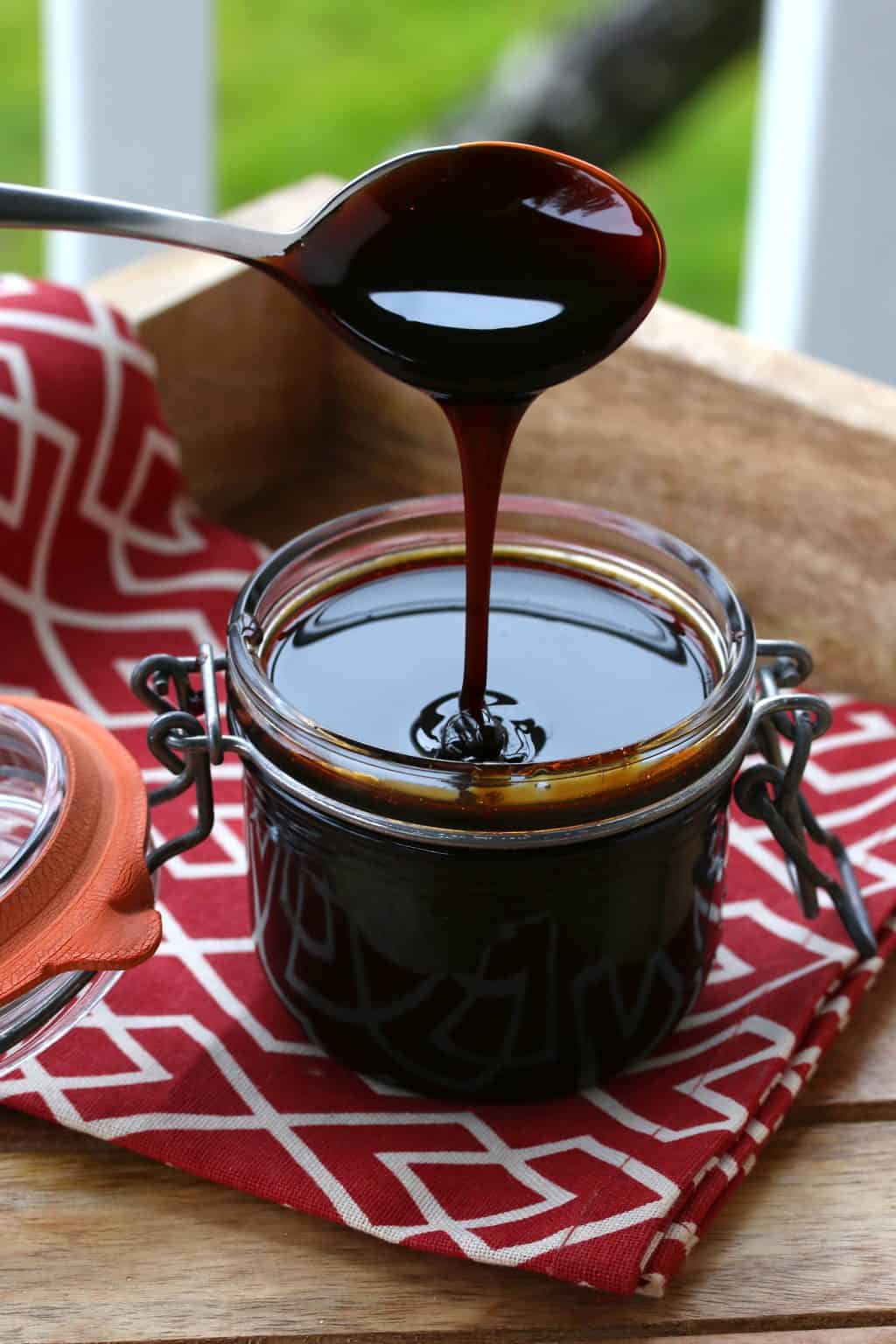
Kecap Manis Recipe
Let’s get started!
Place all ingredients in a small saucepan and bring to a boil. Reduce the heat to medium-low and simmer uncovered, stirring frequently, until the sugar is dissolved and sauce begins to thicken, 10-15 minutes.
Note: The sauce will continue to thicken as it cools so be careful not to over-cook it. But you can get an idea of its thickness by placing a place in the freezer for a few minutes and then spooning a little sauce onto it to see how thick it is when it cools.
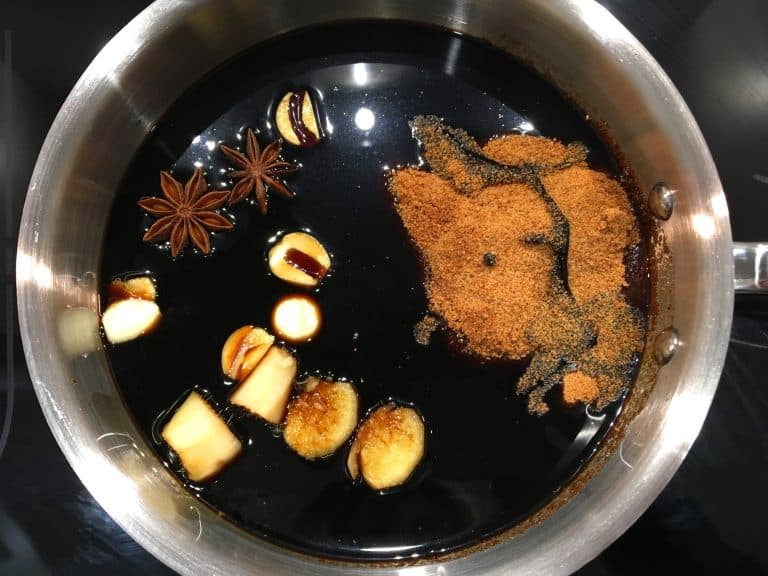
Turn off the heat, cover and let cool completely with the spices, garlic and ginger still in it so they can continue to release their flavors.
Once cool, discard the pieces, pour the sauce into an airtight jar and store in the fridge. It will keep for several weeks.
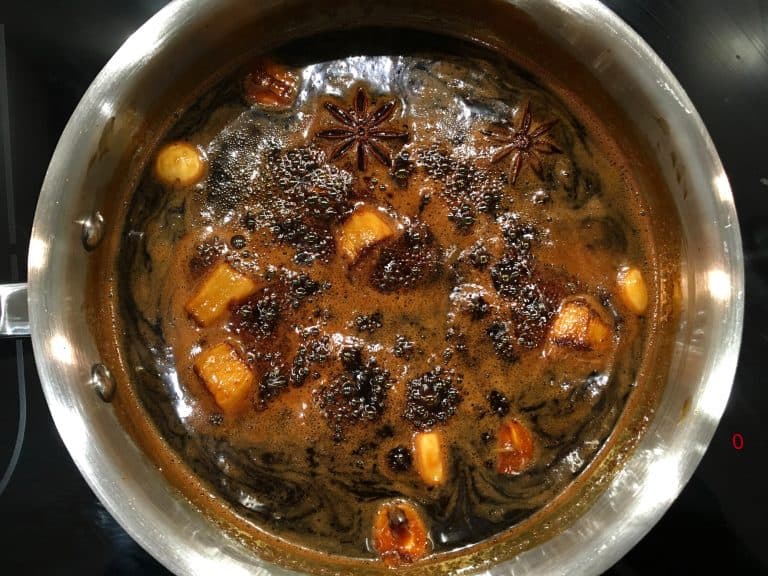
How to Use Kecap Manis
This is one deliciously versatile sauce! It is a central ingredient in the national dish of Indonesia, nasi goreng (fried rice), as well as mie goreng (fried noodles). It’s also commonly used in satays. Try adding it to Asian-style salad dressings, peanut sauces, drizzled over sandwiches, added to scrambled eggs, lightly brushed on grilled corn on the cob, grilled chicken, pork, beef, fish and seafood…the sky’s the limit!
Bottom line: Kecap Manis does wonders for rice and noodle dishes and is equally fantastic added to stir-fries or used in marinades, glazes, soups and barbecue sauces or used as a dipping sauce.
Enjoy!
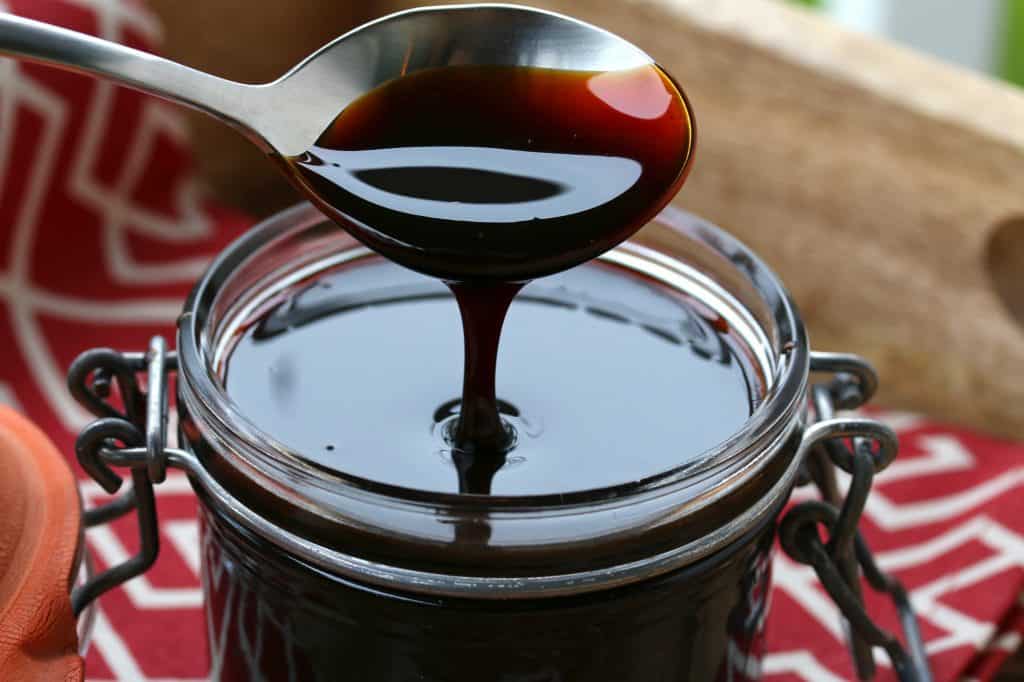
For more delicious sauces from around the world try my:
- Sweet and Sour Sauce
- Teriyaki Sauce
- Yum Yum Sauce
- Hoisin Sauce
- Aji Verde
- Romesco Sauce
- Sriracha Mayo
- Black Bean Sauce
- Eel Sauce
- Plum Sauce
- Sweet Chili Sauce
- Ponzu Sauce
- Char Siu Sauce
- Ginger Sauce
Save This Recipe
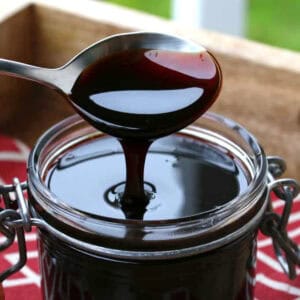
Kecap Manis Recipe (Indonesian Sweet Soy Sauce)
Ingredients
- 1 cup soy sauce (use a brand you know you like)
- 1 1/4 cup palm/coconut sugar or brown sugar
- (Note: Palm/coconut sugar has a rich caramel/butterscotch flavor whereas brown sugar yields a sweeter-tasting sauce, take your pick)
- 1 tablespoon molasses
- 3 cloves garlic, peeled and halved
- 2 inch piece fresh ginger, peeled and quartered
- 2 whole star anise
- 2 whole cloves
- (You can also experiment with adding ingredients like black peppercorns, chilies, coriander seeds, lemongrass, kaffir or curry lime leaves)
Instructions
- Place all ingredients in a small saucepan and bring to a boil. Reduce the heat to medium-low and simmer uncovered, stirring frequently, until the sugar is dissolved and sauce begins to thicken, 10-15 minutes. (Note: The sauce will continue to thicken as it cools so be careful not to over-cook it. But you can get an idea of its thickness by placing a place in the freezer for a few minutes and then spooning a little sauce onto it to see how thick it is when it cools.)
- Turn off the heat, cover and let cool completely with the spices, garlic and ginger still in it so they can continue to release their flavors. Once cool, discard the pieces, pour the sauce into an airtight jar and store in the fridge. It will keep for several weeks. Makes about 1 cup.
Nutrition
Originally published on The Daring Gourmet March 22, 2018



















Hi. I made this sauce this evening and the taste is exceptional! However, it didn’t thicken up in spite of following the direction. Maybe I need to cook it a bit longer? Thanks for the recipe.
I’m so glad you enjoyed it, Emma, thank you! Did it thicken up once it cooled? If not then yes, it just needed to cook longer. You can try reheating it and cooking it a while longer until it thickens.
Made this last night to add in to a curry. I can’t stop dipping my finger in the jar. It’s so good!
I’m so glad you enjoyed it, Jo, thank you!
I tried sushi from a local sushi bar and I was in love with the sweet soy sauce they used. I tried finding a recipe I could make without buying exotic ingredients and I came across this FANTASTIC recipe. I never usually leave reviews but I HAD to for this delicious recipe. I’m so excited to try this on EVERYTHING!
I’m absolutely thrilled to hear that, Pavitra, thank you!
I’m Indonesian living in Perth. Tried this today and I thought I was having lunch at my dad’s home! You are incredible. I thought you are Indonesian with this fab recipe!
That’s wonderful, Jo, I’m so happy you approve and enjoyed this recipe, thank you!
Great recipe. Thank you. I have used these directions many times and highly recommend using palm sugar if you can find it (try health food stores)- it makes a huge difference! Hint: try marinading double cut lamb chops for 24 hours in the kecap manis and grill to med rare over screaming hot coals. Just awesomeness.
Fantastic, I’m so glad you enjoyed it and appreciate the feedback and tips, thank you!
Do you start with dark or light soy sauce?
Hi Richard, you can use either. I personally use dark.
Thanks for this recipe. I make it without the molasses and star anise. Worked out pretty well. Finally made nasi goreng to restaurant taste but was way better.
How long till the sauce expires? How to keep it much longer? Thanks!